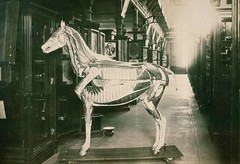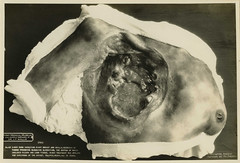
Comparative anatomy, Auzoux model of horse, life size. Specimen no. 2635. [papier mache, on display in Army Medical Museum]. We no longer have the model, although one can be seen in the Science Museum in London.
For many years, models were a way to convey information in medicine and natural sciences. Color printing had to be hand-done, and photography first didn't exist, and then each photograph for a book had to be printed individually and glued into the book. And hand-tinted if required. So well into the 20th century models like Auzoux's above, or ones like this x-ray burn were produced for education.

Breast. Burn, X-Ray. Wax model. No. 92 X-ray burn involving right breast and axilla. Necrosis of tissue producing sloughing ulceration, the bottom of which includes pleura and lung tissue. X-ray treatment was applied for carcinoma of the breast. Colored, woman, age 35 years. Army Medical Museum model prepared by Dr. J.F. Wallis. [Circa World War 1, 1918].
The museum's model-making skills continued into the 1950s, when a technique called moulage, which simulated injuries in rubber overlays were developed. A soldier would put on a moulage of a nuclear radiation injury for example and then the trainees would attempt to treat him. I'll attempt to get some photographs of them up, although I think we scanned the kit's whole instruction book recently as well.
Check out this conference in Europe on models and Auzoux too.
1 comment:
Hey, thanks for the post! You know I covet that model. Nice to see a write-up about the history of anatomical models as well!
Post a Comment